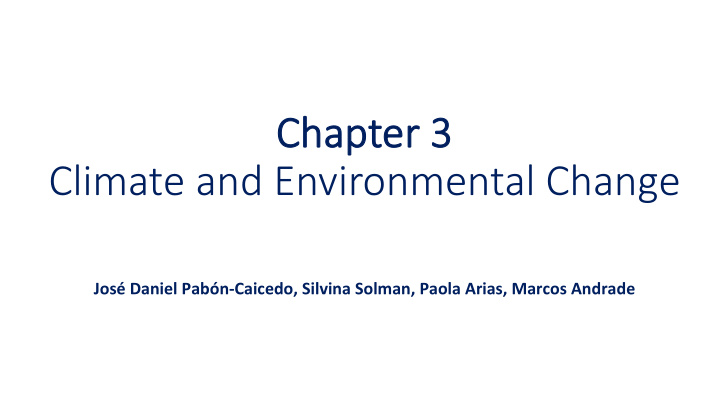



Ch Chapter er 3 Climate and Environmental Change José Daniel Pabón-Caicedo, Silvina Solman, Paola Arias, Marcos Andrade
Kn Knowledge gaps and relevance (1) The immense variety of mesoclimates of the Andes, generated by the interac7on of large-scale circula7on with regional complex topography and by the own regional circula7ons systems, requires a more detailed representa7on in hydroclimate studies. Generalized views of large sub-regions in terms of climate trends and future scenarios are not sufficient to represent the real processes of this environmental diversity. Therefore, for the Andes a more detailed spa7al view is needed in terms of trends and scenarios of climate change. Ver$cal profile of the winds and ver$cal velocity over the Valley of Cesar river at 10°N, as This request put on any regional research agenda simulated by WRF in 10x10 kilometers resolu$on (Armenta-Porras y Pabón-Caicedo, 2016). The valley of Cesar river is located at 73°W approximately, between Serranía de Perija the challenge for producing more detailed data (mountain at the right side) and Sierra Nevada de Santa Marta (mountain at leU side) (Pabón-Caicedo, Bulla-Portuguez, Armenta-Porras, 2018) and informa7on and for developing very high spa7al resolu7on modelling.
Kn Knowledge gaps and relevance (2) For beCer understanding of processes related to the water cycle and energy fluxes in the Andes, knowledge about the effect of climate change on ver7cal posi7on of condensa7on level and cloud basis is necessary. The condensa7on level and cloudiness is relevant for the cloud forest and páramo ecosystems, and their associated hCps://www.biodiversidad.gob.mx/Biodiversitas/Ar7culos/biodiv83art1.pdf environmental services This specific demand of knowledge requires more fine ver7cal monitoring and very high spa7al resolu7on in ver7cal coordinate in modeling.
Kn Knowledge gaps and relevance (3) • As men7oned in paragraph 3.1.2 par7cular sub-regional situa7ons of LULC changes have par7cular effect on local and regional climate and there are not a regional paCern of this effect. Efforts are necessary to spend for producing more detailed knowledge on this specific issue for a variety of sub-regions. To achieve this objec7ve several oriented case studies have to be promoted. Distribución espacial de las coberturas y TST con perfiles de TST ilustrando los cambios de temperatura entre transiciones de coberturas. Top Café- urbana, Bo[om) Urbana- pasto. La línea negra punteada muestra el transecto trazado para elaborar el perfil de temperatura. (Carvajal-Vanegas & Pabón-Caicedo, 2014)
Po Poten=al ac=vi=es • To produce data and informa7on of hydroclimate variables in very high spa7al (horizontal and ver7cal) resolu7on. Building of a special reanalysis for ANDEX is recommended • To carry out several case studies for concrete regions where a dense network of measurements is emplaced • To advance in modeling at gamma-mesoscale (2-20 kms) level in order to have a beCer representa7on of diversity of climate of the Andes • To promote studies on the specific regional climate effects of land use and land cover changes in concrete basin or sub-region of the Andes.
Expected outcome mes • Specific reanalysis for ANDEX program • More detailed knowledge about the hydroclimate processes in small areas of the Andes • More detailed es7mates of climate change trends for the Andes hydroclimate diversity • More detailed (spa7ally) climate change scenarios for the Andes
Recommend
More recommend